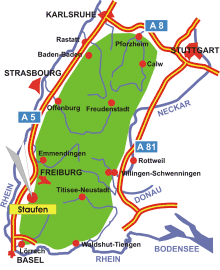Search for the Ancestors of my 3X Great Grandfather, Philip Newell / Noel in the UK and Europe using Ancestry DNA Matches
The biggest mystery in my family tree is identifying where the ancestors of my 3X great grandfather Philp Newell /Noel came from before he became established in the Dock, Bareneed, Newfoundland in the 1780s. The only information we have is that his father’s name might have been James. Any DNA matches with Philip’s father as the common ancestor would be at the 5th cousin level (or greater if they are removed from me). The search for Philip’s origins must; therefore, focus on what Ancestry DNA refers to as “Distant Cousins” (5th or greater cousins). As indicated earlier these matches are near the limit of DNA testing. This does not mean that the people who match me at the 5th cousin level are not related but that I may have 5th cousins that will not show up on the test. Similarly, there might be a 5th cousin relative who is a match to me but one of my more recent Newell cousins might not have this person as a match.
Another challenge is that there is no certainty that Philip’s family name was Newell. We know that Philip was frequently referred to as Philip Noel or Philip Nuel and that the names Newell, Newall, Newill, Noel, Nowell, Newhall, Knowle, Knoll, Knowles, Knowlton, Nevil and Neville were frequently confused in early documents. Given this, we must investigate all of these as possible family names for Distant Cousins. The good news is that, unlike Y-DNA matches (see later discussion), I had a large population of Ancestry DNA autosomal 5th + cousin matches with at least one of these names in their tree. Having a match with one of these names does not necessarily establish a link through that name but does make this person a candidate for one of my “Newell” ancestors. Another issue to be aware of is that establishing a match involves matching DNA (generally reliable) and finding a name in a persons published family tree. The reliability of the info in most family trees starts to drop off after 6 or 7 generations; so while it is relatively certain that I match that persons DNA it is much less certain that that person has one of these names (especially if it is not the paternal family name).
My methodology was to sort my list of Distant DNA matches for each of the candidate names which gives a list of people matching my DNA with this name in their tree. I then excluded matches that had made their tree private, unless I obtained info from them, and individuals with very limited data in their tree (e.g. just a name but no location & or dates). In cases where there were multiple matches with same tree (same admin) I only used the first reference. Of the names I searched, only four produced significant numbers of matches; these were: Newell, Knowles, Noel and Neville. Others like Nowell, Newall, Nevil and Knoll had limited number of matches and frequently included another name so are likely a different spelling of one of the more common names. (e.g. Nowell>Noel; Newall>Newell; Nevil>Neville; Knoll> Knowles). I have prepared a shared Spreadsheet that compares the number of matches by location for the four main names (to view right click link and select open in new Tab). In the preceding analysis (see shared Spreadsheet ) there were a limited number of Old World matches compared to those for New England and Nova Scotia and apart from a peak in Lancashire they were scattered across the UK. Overall, for all 4 names there is a higher frequency of matches for these four names from the North of England & Scotland than from the south of England (even more significant when adjusted for population). My Y-DNA results (see Y_DNA Results Section) that track my paternal (Newell) DNA also suggest a stronger connection to the north of England and south Scotland than to the south of England (note: this only applies to my Newell ancestors (Y-DNA) since many of my other ancestors roots trace back to Devon and Dorset).
Ancestry provides a separate analysis of your ethnicity based on makers in your DNA (see a separate sub section of this report on Ethnicity Estimates). In October, 2019 Ancestry identified my ethnicity as:
- England, Wales and Northwestern Europe 81%
- Ireland & Scotland 15%
- Germanic Europe 4%
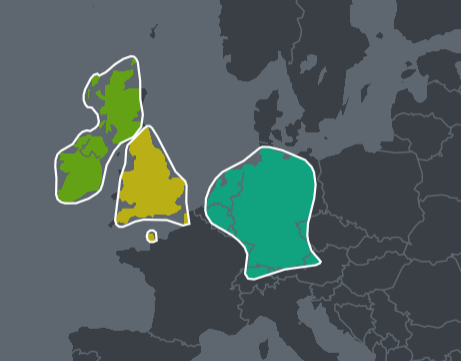
At that time Ancestry gave the following Ethnicity estimates for my Sister:
- England, Wales and Northwestern Europe 85%
- Ireland & Scotland 4%
- Germanic Europe 2%
- Sweden 9%
Analysis of 54 3rd, 4th and 5th cousin matches with links to the Newell name in Newfoundland gave the following averages:
- England, Wales and Northwestern Europe 62%
- Ireland & Scotland 26%
- Sweden & or Norway 5%
- Germanic Europe 3%
These averages are not dissimilar from overall averages for the UK and other than suggesting origins in the UK provide very little indication of where my ancestors originated.
Searching for my Newell Roots in the Old World using matches to distant cousins
Given that my Newell ancestors almost certainly had their origin, however distant, in either the UK, Ireland or mainland Europe, I set out to map distant (5th cousin +) Ancestry DNA matches to people with the Newell name and variants of this name in their tree. For each DNA match I mapped the location associated with their most distant Newell ancestor in the ‘Old World’. I only mapped data for cases where the location of the ancestor was know to the town or county level. There is a high probability that any individual might lose some of these distant connections but, thanks to my sister Shirley and two 3rd cousins that share a common Newell Ancestry giving me access to their match data, I was able to adjust for this by plotting matches for four decendants of John Newell and Patience Porter. Having data for the two 3rd cousins also reduces the effect of matches that might be linked to my more recent non Newell ancestors.
The following map shows the location (Old World only) of the earliest Newell ancestor [of the match] for cases where there was a match to myself, my sister or one of the 3rd cousins.
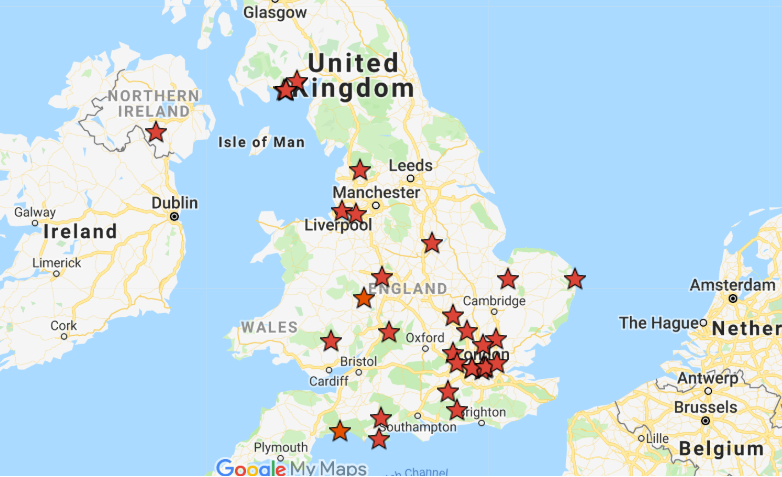
Perhaps the most striking aspect of this map is the low number of matches (34 including two Newalls, two Newills and one Newhall). The matches tend to have a strong cluster around London (including Sussex, Buckinghamshire, Bedfordshire and Hertfordshire) and smaller clusters in Lancashire, southwest Scotland, the midlands of England and Devon / Dorset. The Newell name had no matches in mainland Europe.
Several of the early Newell and Newhall families of Massachusetts trace their roots back to Buckinghamshire (see Section III for links to Colonial America). The cluster around London might reflect:
- an original source region,
- migration to England during and immediately following the Norman Conquest (1066+),
- later (post 1400) immigrants from Europe gravitating to London (see Immigrants),
- migration from other parts of the UK (e.g. Scotland, the North of England, Ireland or the Southwest) to London.
Based on analysis of my Y-DNA results (haplogroup and STR), which better reflect early (pre 1500) origins, it is unlikely that the area around London represents the original source region.
The previous discussion is based on the assumption that Newell (or Newall) was the original family name; however, another theory, explored below, is that the the original family name was not Newell but a similar name that morphed into Newell. Research into my family history in Newfoundland shows that prior to 1800 the family name was frequently recorded as Noel. The following sections explore this theory by mapping DNA matches to similar names.
The first name mapped was Noel which was the name recorded in the earliest family records (pre 1800). This name had 14 matches in the UK and Europe including one Noell. One Noel (in Surrey) was a double match with Newell in a case where both names were linked to the same family. The Noels were clustered in the Channel Islands, along the eastern border of France, the Netherlands and south England.
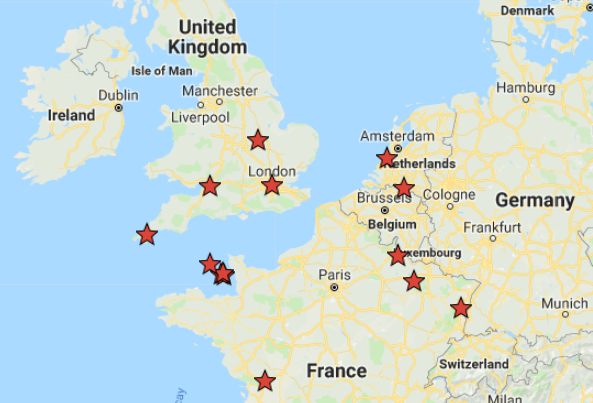
The Noel name was the only name with matches to the Channel Islands. It should be noted that I did not include matches that traced their Channel Island roots through Clement Noel of Harbour Grace, Newfoundland. The Noel matches in eastern France fall within the Alsace Lorraine region (see map below) that borders Germany and some parts of which were historically part of Germany. The Protestant populations of eastern France, in Alsace, Moselle, and Montbéliard were mainly ethnic German Lutherans.
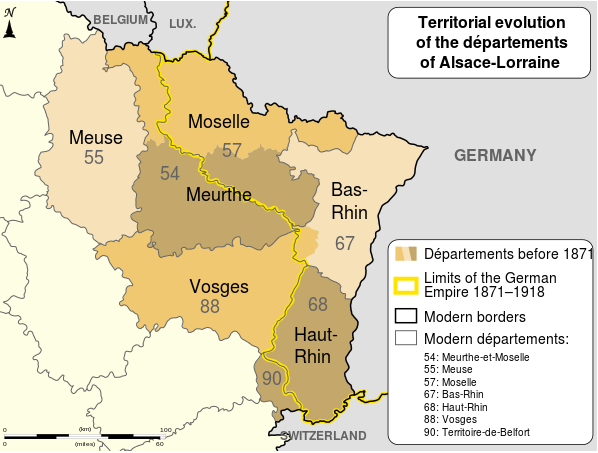
The next name mapped was Neville (see map below). This name might seem to be totally unrelated unless you understand that in Ireland the names Newell and Nevill are frequently interchangeable. The reason being that the letters V and W did not occur in the Gaelic alphabet. In my research on the Newells of Ireland I frequently found the same person referenced as Newell by English sources and Nevell by Irish sources. As expected matches to this name was found in Ireland but also in the north and midlands of England (an areas settled by Irish immigrants).
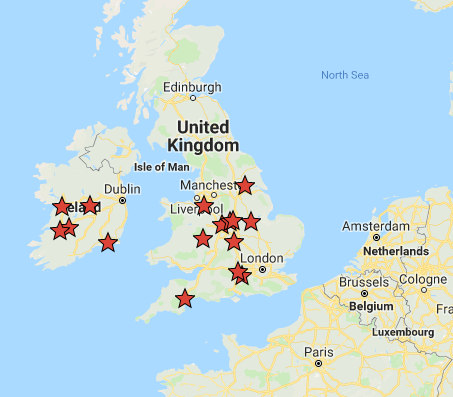
The last of the four main name mapped was Knowles. This name is clustered in Lancashire with a few matches in south England. The distribution of the Knowles matches (from Ancestry DNA) is a better fit to the Y-DNA STR matches. There is more discussion of this name in subsequent sections.
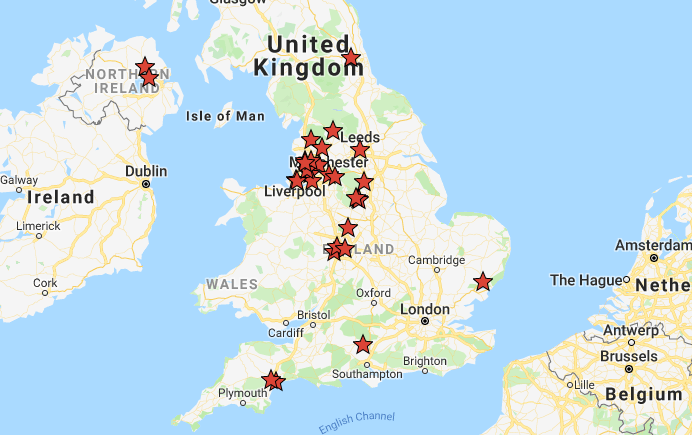
The preeceding discussion has focused on the four names (Newell, Noel, Neville and Knowles) identified in the earlier analysis of my DNA matches. What is clear from this more indepth analysis of DNA matches, for four individuals with Newell ancestors from ‘the Dock’, is that a case could be made for any of these being the original name for the “Dock Newells”. One possible interpretation is that one of these or possibly a completely different name was the source and the others arose from this core. Given the family history of the Old World matches it is almost certain that this divergence occured prior to 1500 since family names started to become standardized around this time. I am not argueing that all Newells, Noels, Nevilles and Knowles are related but that my ancestors adopted these different spellings of their name, perhaps to fit with the name most common in the area where they lived.
We might get some sense of how this could have evolved by examining how the names might have evolved. The following Diagram list some of the names I investigated in my research. The four names examined earlier are in the upper section of the diagram. The lower section list some related names that might be candidates for a root name.
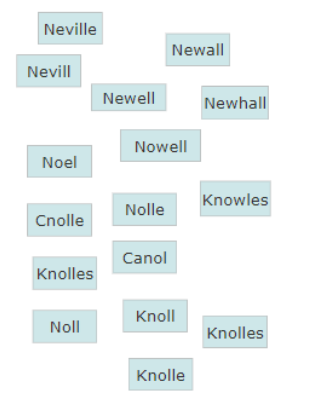
The first new set of names I examined were some that are similar to Noel (see Noel + map below). These include: Nowell (8), Noll (11), Nolle (1) and Noall (5). The following map plots these along with the Noel data. The new data added Nowell matches in the north of England (Derbyshire) and Wiltshire; it also added a significant number of Noll matches in Germany and Noall matches in Cornwall. Noll is a German name with one possible source for Noll being from Middle High German nol ‘hillock’, ‘knoll’. The Noll matches in Germany appear to be geographically related to the Noel matches in eastern France, possibly reflecting different versions of the same name. Within France, the Noll name is most common in the Alsace Lorraine region bordering Germany.
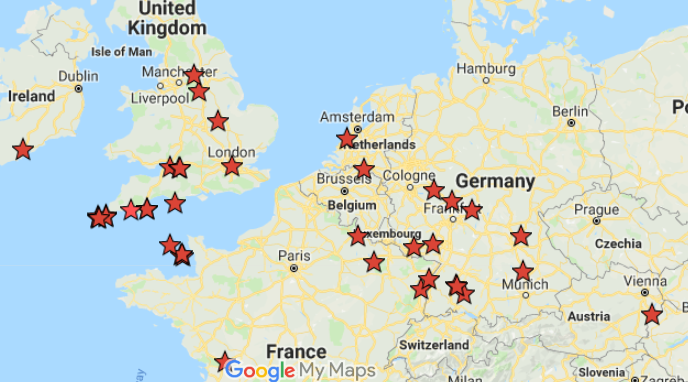
Since, as indicated above, the German name Noll may be related to Knoll (hill) I searched for DNA matches with the Knoll name (see map below). This produced 8 cases with all of these in Germany. The highest frequency is in the State of Baden-Württemberg (home of the Black Forest) which was also the case for Noll.
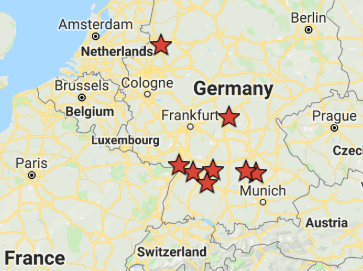
I did not find any Knoll matches in the UK; however, there were five matches to Knel in southern England and one to Knill in Cornwall that may be related (knoll Middle English variant of knell ).
To this point we have built a case that there is a large cluster of “Dock Newell” DNA matches along the course of the Rhine River between Amsterdam and the Black Forest. On the French side these are associated with the Noel name while on the German side they are associated with Noll and Knoll.
One other group of names names possibly associated with a hill in early English records include the names Cnoll, Canol, Cnolle, Canoll. In Middle English knolle is a ‘hilltop’, ‘hillock’ and in Middle High German knol is a hill or ‘peak’; however, in Old English is the word for hill is cnoll (Old English cnoll “hilltop, small hill, clod, ball,” related to Old Norse knollr “hilltop;” German knolle “clod, lump;” Dutch knol “turnip,” nol “a hill.” https://www.dictionary.com/browse/knoller ).
Cnoll, Cnolle, Canol and Canoll occurs as names in early Norman records for different areas of England. Note: The sound of the French letter “C will change depending on if it is followed by a hard or a soft vowel: soft pronunciation – In front of an ‘E,’ ‘I,’ or ‘Y,’ the ‘C’ is pronounced like an ‘S’ ; hard pronunciation – In front of an ‘A,’ ‘O,’ ‘U,’ or a consonant, ‘C’ is pronounced like a ‘K’ https://www.thoughtco.com/french-pronunciation-of-c-1369549 . Thus cnoll (old English for hill) when used as a name would be pronounce like Knoll.
The English publication The Parliament Writs list a number of references to individuals with the Cnolle name in the 1300s (see below):

The Oxford Dictionary of Family Names in Britain and Ireland list Cnolle as an early version of Knowles. Sir Robert Knowles a noted English mercenary fighting in Brittany and France in the 1300s was referred to as Sir Robert Canolles or Canole by French writers. A family Web Site for the Knell / Knill family names ( http://knightlyfamilies.com/intro1.htm ) has several comments sections (1 &3) that demonstrate that Cnoll, Cnolle were linked to the Knell families in England and that in the immediate centuries following the invasion these names were used interchangeably with Knell, Knill, Knolles, Knowles. By the fifteenth century in England the names Cnoll, Cnolle, Canol and Canoll were superseded by Knoll, Knolle, Knowles, etc.. In France there are historical records of the name dating from the 1600 mainly in the Charente-Maritime region (Rochelle) but virtually no modern references (see https://en.geneanet.org/ ). Many of the historical French records link to individuals that subsequently emigrated to the French colony of Acadia (now Nova Scotia).
There were DNA match to the Canol name, with all four “Dock Newells” investigated having matches and all but one having multiple matches. However, all of these matches had the same individual in their tree.
Marie Anne De Canol, BIRTH 1651 • St Martin De Re, La Rochelle, Charente Maritime, France DEATH 1693 • Pisquid, Minas Basin, Acadia, Canada.
All the links to Canol were linked to Marie Anne and her husband Jean Doiron; however, there were even more links to the Doiron name; perhaps linked to the 7 children they had in Port Royal, Acadia (now Nova Scotia). one of these children was Noel Doiron (c 1684 – 1758) who was referred to as the “father” to all the Acadians on Ile St. Jean (present-day PEI ) and was the namesake of the village Noel, Nova Scotia (see https://en.wikipedia.org/wiki/No%C3%ABl_Doiron ).
The preceding discussion has examined DNA matches between a group of “Dock Newells” and individuals with roots in Europe and the UK that have names in their tree that are generally recognized as having possible links to Newell or Noel. In the course of this research I identified several other names which had DNA links that are only tangentially related to Newell or Noel but where there are other factors that potentially link them. The left side of the following diagram list some of the other names I examined.
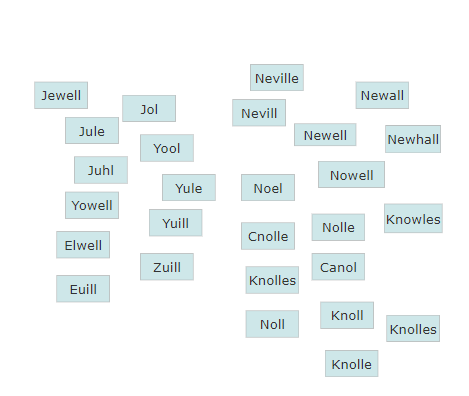
The most interesting name on this list is Yule which Ancestry describes as:
A Scottish and English: nickname for someone who was born on Christmas Day or had some other connection with this time of year, from Middle English yule ‘Christmastide’ (Old English geol, reinforced by the cognate Old Norse term jól). This was originally the name of a pagan midwinter festival, which was later appropriated by the Christian Church for celebration of the birth of Christ.
Within the UK the name Yule is most common in Scotland. This Scottish bias likely occurs since prior to the Scottish Reformation of 1560, Christmas in Scotland was known as Yule . This is likely a result of the Scandinavian influences in northern Scotland. From the 8th to the 15th centuries Norse settlers, mainly Norwegians and to a lesser extent other Scandinavians, colonized parts of what is now Scotland. This origin of the name Yule is relevant since the name Noel is derived from the Old French Nouel, from noel, nouel (natal, Christmas), which is from the Latin natalīs diēs (birthday of the Lord e.g. Christmas). My earlier speculation that the original family name for my family may have changed to similar sounding local names when my ancestors moved into new regions can be applied in a somewhat different way in this case. Rather than adopting a similar sounding name a transition from Noel to Yule might represent a case of adopting a name with the same meaning. Like most names there appears to be some variation in the spelling of the Yule name which is reflected in the DNA matches. Some of the variations with DNA matches include Yuill, Youell and Youle. The following map plots the distribution of the matches to these names. There were 23 matches including 2 matches in England with the Youell spelling and one Yuill in Ireland. Apart from these and several matches in northern Scotland the bulk of the matches are clustered around Edinburgh and Glasgow.
Comparing this map with earlier maps for other names such as Knowles demonstrates that with the exception of several Newell & Newall matches around Kirkcudbright, Scotland (see my research on the Newalls of Scotland) there were no other matches to the other names north of Lancashire. The gap between the Yule matches which are clustered around Edinburgh and Glasgow and Lancashire can be partially explained by the low population density in the Lake District and the Scottish Border.
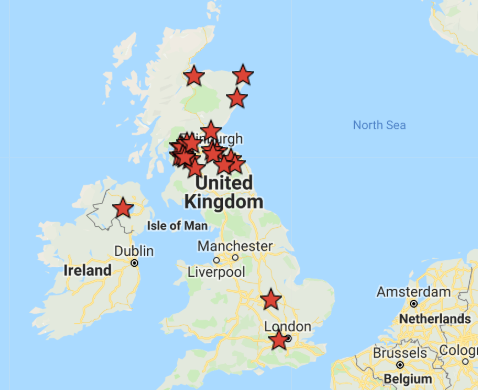
Research on the Yule name in Scotland (also recorded as Youle, Youll, Yoell, Youell, Youhill, Yuill, Yuille, Zuill and Zowlle) demonstrates that in 1374 a John Yule was recorded in Haddington and in 1391 another John Yule was a chaplin in Aberdeen. By the mid 15th century the Yules were established in Edinburgh, Aberdeen and Haddington (see: link for a detailed history of the Yule family of Haddington. In 1503 Sir Robert Yule was a Taxman in the Orkneys, and Inza Yule held lands in Firth in the Orkneys. In 1610 a “Patrik” Yule was skipper of the ship “Unicorne of Leyth” bound for “Orknay”. In 1676 the Yules emerged with two senior houses, the Yules of Darleith House, Cardross (NW of Glasgow) , and the Yules of Leyhouses (formerly in Haddington now in East Lothian). A more detailed view of the Yule matches in Scotland (see below) demonstrates that there are clusters near Edinburgh and Glasgow. The Yule spelling occurs more frequently in the Edinburgh cluster and the Yuill spelling in the Glasgow cluster.
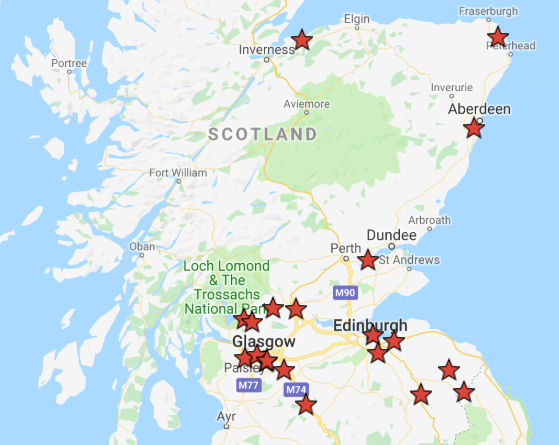
By the 18th century the Yuille family of Darleith were tobacco merchants in Scotland and Virginia. Before 1774, when dredging of the River Clyde allowed ships to take merchandise directly to Glasgow, tobacco and other goods were offloaded downstream at Greenock or Port Glasgow. Interestingly both of these towns had strong connections to Newfoundland:
Merchant firms at both ports had been regularly trading with Newfoundland and Labrador since the 1770s, when the American Revolution severed their trade ties with the American colonies. Between 1781 and 1791, approximately 74 vessels left Greenock for the island of Newfoundland to trade provisions and gear for saltfish or other goods. https://www.heritage.nf.ca/articles/society/scottish-settlement.php
Earlier I had suggested a possible link between the Yuel and Noel names. In this regard it is interesting to note that c 1109 a Ralph (or Radulf or Roger) Nowell or Novell or Nouell or Nuel was consecrated Bishop of Orkney. This Ralph was reportedly a priest in York before he was consecrated by the Archbishop of York. Unfortunately for Ralph his tenure was short since the Norwegians who had control of Orkney had appointed their own bishop; however, Ralph still acted in that capacity from York. Ralph is reported to have had several children, several of which entered the Church.
The final family names that I investigate were Jewell and Juel. These names are only very loosely connected to Newell/Noel. Jewell is similar to Newell (see Ancestry) and Juel is similar to Yule. The following is some background on the possible origins of these names:
Jewell is an English surname of French Breton or Celtic Cornish origin. The root is the Old Breton Iudicael or the Celtic Judand hael, composed of elements meaning “lord” and “generous” or “bountiful.” The name was borne by a 7th century saint, a king of Brittany who abdicated and then spent the last part of his life in a monastery. As Jule, Jewel, Jewell, or even Jekyll, it was a name found mainly in Devon and Cornwall. Judhael de Totnes from Brittany, a prominent supporter of William the Conqueror, was granted a large landholding in Devon after the invasion. He may have been the origin of many of the Jewell names in that county. http://www.selectsurnames3.com/jewell.html
Juhl is a surname originating in Denmark. In Danish, “Juhl” is pronounced ‘yool’ or ‘yooh’. In American-English, “Juhl” is pronounced the same as the English word ‘jewel‘ or Jool. https://en.wikipedia.org/wiki/Juhl
I had investigated the Jewell name in the past since there was a Philip Jewell and a James Jewell (somewhat similar to my Philip and James) living in Lanivet, Cornwall in the late 1700s (see https://books.google.ca/books?id=fxGkBAAAQBAJ ).
When I plotted Jewell and Juel matches for myself, my sister and the two cousins (see map below) I found a strong cluster of Jewells in Cornwall and NW Devon; a scattering of matches in southern England (includes one each of Elwell, Kewell, Joel and Judkins); and three matches in northern Germany (two in the Holstein region bordering Denmark).
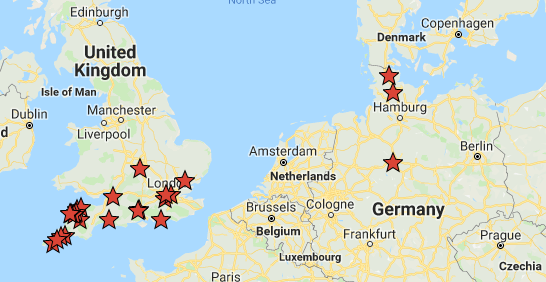
The Jewell matches in NW Devon are interesting since there were Newells from this area (Barnstaple, Devon) that were involved in the Newfoundland fishery in the 18th century but I found no Newell DNA matches from this area.
The one final map (below) is a summary of the DNA matches for all the names investigated:
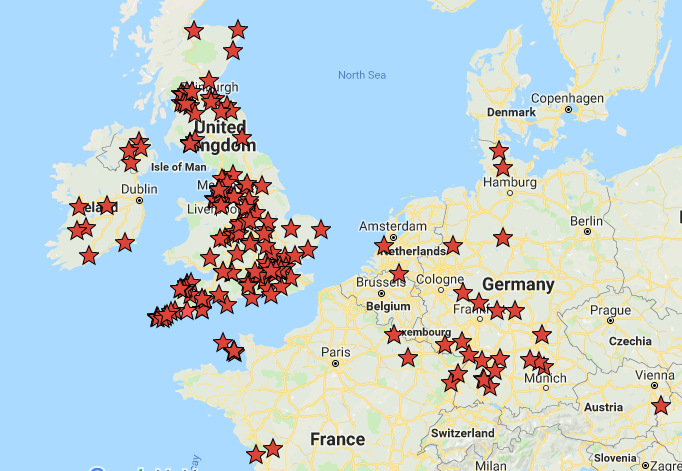
This map indicates that the “Dock Newells” have numerous distant DNA links to people with Newell, Noel, etc. names in the UK. In addition, there are a scattering of matches to Ireland which likely represents out migration from Scotland and England, a cluster near the Black Forest in Germany and scattered matches along Rhine and along the Atlantic coast of France. It is not unreasonable to speculate that there is an apparent “dead zone” in central France that may be a result of the French wars of religion.
My DNA links to one non Newell linked name are especially interesting. In my research on the merchants connected to my family in Newfoundland I investigated the link between my 3X great grandfather Philip Noel/Newell/Nuel and the Harbour Grace merchant John Charles Nuttall. In 1817 Philip was dealing with the firm of Nuttall & Cawley and interestingly Clement Noel of Harbour Grace also had dealings with the same firm. At that time John Charles Nuttall was relatively young (born 1791) and was new to Newfoundland. Nuttall was from Bristol but appears to have had family roots in Lancashire. There is no evidence of family connections to John Charles but it did prompt me to check for DNA links to the Nuttall name.
The Nuttall / Nuthall name is found mainly in Lancashire (in 1891 77% of Nuttalls lived in Lancashire) and myself, my sister and my Newell cousins all get a significant number of matches to the Nuttall / Nuthall name that cluster north of Manchester (see Map below). Given that Nuttall is a relatively uncommon name the number of matches is surprising.
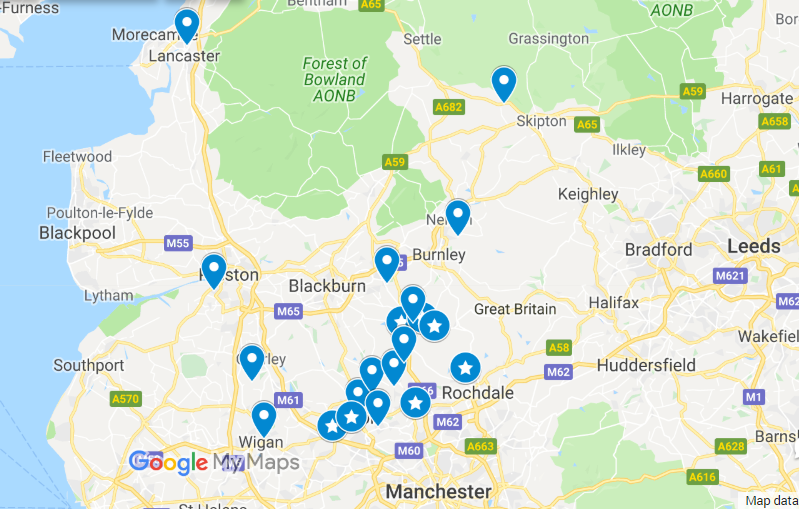
There are records of similar names in this area since the 14th century (Nuthough, Nuthaw, Notehoh, Notehogh and de Notoghs) and by 1500 the Nuttall name was established in this area.
Charles Nuttall made a settlement of his lands in Little Holcombe; and in 1549 he made a further settlement, Richard his son and heir, being a party. In 1561 Richard Nuttall, whose heir was his son Charles, made a lease of certain land. Charles Nuttall, gentleman, was buried 8 Mar. 1604–5; Charles Nuttall of Holcombe, 1 Aug. 1613; and Richard Nuttall of Nuttall, 20 Jan. 1616–17; Bury Reg. Charles Nuttall of Nuttall was a freeholder in 1600, and another Charles contributed to the subsidy in 1622; Misc. (Rec. Soc. Lancs. and Ches.), i, 248, 162. He was living in 1624, and Blome names the family in his list of Lancashire gentry in 1673 (see: History Townships: Tottington).
The Nuttalls of Lancashire lived in close proximity to many de Knolls Knowles, Newells/Newalls, Newhalls and Nowells. A researcher James T Newell (see references in Part II) has explored possible links between the Nuttall name and Newell.
The Scottish Mystery
Prior to starting this recent research, if asked about Scottish connections, I would have said that to the best of my knowledge I had no Scottish ancestors. The matches to Yule, described earlier, can be explained by the Scottish Yules representing an early (pre 1400) offshoot of Noels from North England who adopted a different spelling of their name or a pre 1800 connection through marriage. However, other data point to a deeper connection with Scotland.
The results of my Y-DNA test indicated that I am connected to a Y-DNA Haplogroup that has a cluster of modern matches in the Argyll and Bute region of Scotland and Y-DNA STR data, if adjusted for population, suggest that I have similar numbers of matches in England and Scotland. To investigate this further I started comparing my total number of Distant DNA matches (regardless of name) in selected areas of England and Scotland. In England, I compared areas that have connections to a significant number of my non Newell ancestors (e.g. Devon and Dorset) and areas in the North of England (e.g. Lancashire) that are connected to the Nowell and Knowles names. In Scotland, I examined areas with connections to Yule and Y-DNA data. Not surprisingly, at the county level Devon, Dorset and Somerset had the highest number of matches followed by Lancashire. However, England has 10X the population of Scotland. When adjusted for population Dorset had the highest density in England but in Scotland the density of matches was even higher in Argyll (NW of Glasgow) and Midlothian (historical county south of Edinburgh). At the town/ village level when adjusted for population the towns of Lyme Regis in Dorset, Uplyme, Bidford, Brixham, Newton Abbott and Barnstaple in Devon had the highest density in England. However, in Scotland a number of towns had a higher density of matches; these towns include: Rothesay, Bute; Earlston, Berwickshire; Kirkcudbright; Dumfries; Bonhill, Dumbarton and Cardross, Renfrewshire. The latter two towns are within a few miles of Darleith House which is connected to the Yule family; Earlston is approximately 25 miles south of Haddington (Yule); Rothesay is near the center of the Haplogroup matches identified in the Y-DNA section; and Kirkcudbright is the centre of the Newell DNA matches in Scotland.
In the Y-DNA Section I speculated that the cluster of Y-DNA Haplogroup matches might be linked to descendants of Alan FitzFlaad, a Breton who came over to Great Britain not long after the Norman conquest. Alan had been the hereditary steward of the Bishop of Dol in the Duchy of Brittany; Alan had a good relationship with the ruling Norman monarch Henry I of England who awarded him with lands in Shropshire. The FitzAlan family quickly established themselves as a prominent Anglo-Norman noble house, with some of its members serving as High Sheriff of Shropshire. It was the great-grandson of Alan named Walter FitzAlan who became the first hereditary High Steward of Scotland, [founder of the Scottish Stewarts/Stuarts] while his brother William’s family went on to become Earls of Arundel see https://en.wikipedia.org/wiki/Alan_fitz_Flaad. This family has been linked to the Allen/Allan and Stewart/Stuart names in Scotland.
A branch of the Stewart family became established in the area of Argyll and Bute (see map below) by the 15th century. James Stewart was sheriff of Bute between 1445 and 1449. He was succeeded by his son, William, who was also keeper of Brodick Castle on Arran. In 1627 Sir James Stuart of Bute was created 1st Stuart Baronet, of Bute in the Baronetage of Nova Scotia by Charles I of England .

Based on this theory first developed from the Y-DNA research I investigated my DNA links to the Stewart and Allen/Allan names. The number of matches to these names were higher than any of the Newfoundland names in my tree. The high number matches to Stewart is likely partially a result of the popularity of the name in Scotland (7th most common) plus the genealogical interest in this name. By comparison, Yule/ Yuill only had 7% of the matches that Stewart had; however, Yule is not a well know Scottish name (ranks number 626 in list of Scottish names). Other common (top 12) Scottish names with high number of matches include: Campbell (who were Earls of Argyll), MacDonald / McDonald and Scott. Distant DNA links to popular Scottish names such as these only suggest that my distant ancestors likely had some connection with Scotland, either directly or through marriage.
Researching the history of the Yule family I identified several families that had close connections with the Yule family. These include:
- Buchanan (Yules, Yuill, Yool and Zuill are listed as Septs of Clan Buchanan),
- Shaw (link through Shaw Stewart Baronetcy, of Greenock), and
- Crawford (links through Greenock, Darleith House and Virginia)
A search of my DNA matches for each of these names (none of which is in Top 50 Scottish names) and Scotland produced the following distant matches : Buchanan (39), Shaw (55) and Crawford (53). Matches for my sister and the two Newell cousins noted earlier produced similar results (see below).

When comparing the statistics presented above with the map of Yule matches it should be noted that the Yule map only includes cases where there is a direct link between the one of the Yule names and a specific location in Scotland while the Table above includes any results from an Ancestry search of DNA matches that has the name plus Scotland in the location. I have added a new metric (Matches / 100K) to the chart to try and adjust for the differences in the frequency of different names in Scotland (note: the population of Scotland in 1841 was 2,620,841). Based on this Yule / Yuill has the highest frequency, followed by Shaw then Crawford then Buchanan and finally Stewart. All of these families have connections to the area west and north of Glasgow (e.g. Bute, Greenock, Bonhill, Cardross, Drymen). It should be noted that the statistics in the table above includes all Stewarts spread through Scotland not just those of Bute referenced earlier.
There are several interesting sideline regarding the Shaw connection. The Shaws of Greenock are connected to the Shaws of Sauchie. The lands of Sauchie (NW of Edinburgh) were granted by King Robert the Bruce to Henri de Annand, Sheriff of Clackmannan, in 1321 and in 1431 Sir James Schaw of Greenock, Comptroller to the King, acquired the lands of Sauchie when he married the heiress Mary de Annand. This branch of the Scottish Shaws are considered Lowland Shaws and likely have separate origins from the Highland Shaws.
The male line of the Shaws of Greenock died out after the death of Sir John Shaw of Greenock, 3rd and last Baronet and the family titles and lands transferred to the Stewart (later Shaw-Stewart Baronetcy) of Greenock and Blackhall. The 4th Stewart Baronet married Margaret, daughter of Sir John Shaw, of Greenock, 2nd Shaw Baronet of Greenock. The fourth Stewart Baronet succeeded to the Greenock estates on the death of his great-uncle Sir John Shaw of Greenock, 3rd and last Baronet in 1752 and assumed the additional surname of Shaw.
The Stewarts of Blackhall are descended from Sir Archibald Stewart, the first Baronet of Blackhall who was made a Baronet of Nova Scotia in 1667, and his wife Anne Crawford. This Stewart family is descended in the direct male line from Sir John Stewart, illegitimate son of Robert III of Scotland (see Burke).
Three Covered Cups
The family crest of the Shaws of Sauchie incorporated 3 covered cups on a shield (see below). The Arms of the town of Greenock also incorporates three covered cups from the arms of Shaw of Greenock. .
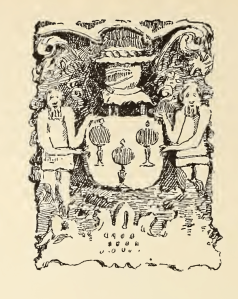
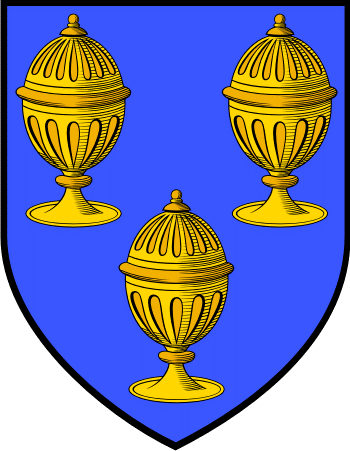
This element, three covered cups, in the Shaw Arms also occurs in the Arms of some branches of the Butler family but with a red shield. The Butlers are a Anglo-Norman family that originated from Theobald Walter (sometimes Theobald FitzWalter, Theobald Butler, or Theobald Walter le Boteler), the first Chief Butler of Ireland. He also held the office of Chief Butler of England and was the High Sheriff of Lancashire for 1194 (see also Botiller or Butler, barons of Warrington, Lancashire). He was the grandson of one Hervey Walter who, in the time of Henry I., held Witheton or Weeton in Amounderness, Lancaste; the manor of Newton in Suffolk; and certain lands in Norfolk. Walter is a Germanic personal name composed of the elements ald, meaning rule and heri, meaning army.
The Argentine family also has three cups covered in their Arms. Starting in 1193 Reginald de Argentine was Sheriff of Cambridge, Huntington and later Essex and Hertford. By the 13th century this family was established at Great Wymondley in Hertfordshire. It is likely that this family had French origins; possibly the Arrondissement of Argentan, in Normandy or Argentine, a commune in the Savoie department in south-eastern France. This latter location has links to Conrad II (of Savoy) who was descended from Frederick of Staufen (see below).
The Argentine family also had early (c 1317) connections through marriage with the Boteler / Butler family. There is evidence that this family were cup bearers to the King as early as Henry I which may account for their Arms. A review of a recent book on this family describes them as:
This forgotten family of crusaders, jousters, warriors, matriarchs, and rebels, were influential in some key historical events, both locally and nationally. Examples include the signing of the Magna Carta, the Battle of Bannockburn, the death of Edward II, the Hundred Years War including the Battle of Agincourt, and the murder of the Princes in the Tower. Unfortunately they also had the knack of frequently backing the wrong horse politically, and feuding amongst themselves, which led to the family never quite making it into the upper reaches of the medieval nobility and ultimately fading into obscurity.
In terms of this research the most interesting connection is that this element (three covered cups) also occurs in the Arms of several branches of the Nowell family (see early example below).

Burke’s General Armory of England indicates that “three covered cups” are incorporated into the Arms of Nowells from: Kent, Lancaster, Sussex and Middlesex. The Nowells of Read, Lancashire is one of the families incorporating “three covered cups” in their Arms (see Visitation of Lancashire 1613). William Nowell of this family moved to Battle, Sussex from Lancashire in 1500s. John Woolton (or Wolton) (1535?–1594) who served as Bishop of Exeter in Devon used the Nowell crest of three cups. His mother Isabella Nowell, a daughter of John Nowell of Read Hall near Whalley, and sister of Alexander Nowell (c. 1517 – 13 February 1602), Protestant theologian and Dean of St Paul’s.
Three covered cups also occurs in the Arms of the Newalls of Townhouse (see: The History of the Parish of Rochdale in the County of Lancaster). Townhouse is situated near Littleborough, Manchester (prior to 1974 this area was part of Lancashire). Robert Newall, the earliest documented Newall of Lower Town House was born c 1599 and was buried in January 1681-2. Three cups also appears in the Arms of the Knowles of Swinton, Lancashire; however, this may be a result of connections to the Newells of Hare Hill.
Apart from suggesting a possible connection between the Shaws of Sauchie and some Nowells and Newalls of Lancashire there is one other interesting connection to “three cups”. In researching this topic I searched for early European Arms containing three cups. I only found one example and that was the Lords of Staufen who had three cups on their family crest. Staufen im Breisgau is a German town in the Breisgau-Hochschwarzwald district of Baden-Württemberg, Germany. Staufen is situated on the southeastern edge of the Black Forest (see Map below). Staufen Castle was built to protect the rich silver mines in the Muenster Valley. These mines were the main source of income for the Lords of Staufen. The castle was built or at least acquired by Duke Frederick I of Swabia in the latter half of the 11th century. The Staufen Burg was occupied by the Staufen family up till the start of the 16th Century when the last in the Staufen line died ( see http://www.staufen-im-breisgau.de/geschichte-en.html). French and Swedish (Catholic) troops occupied the city during 1600s and oppressed the protestant population. The name “Staufen” itself derives from Stauf meaning “chalice”. This term was commonly applied to conical hills in Swabia in the Middle Ages (see also Hohenstaufen ). Both Richard of Cornwall (2nd son of King John of England and King of Germany from 1257). and Alfonso X of Castile have links to the Staufen Dynasty.
